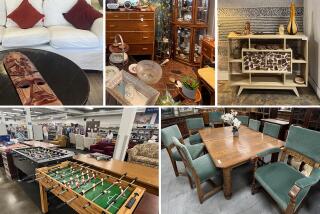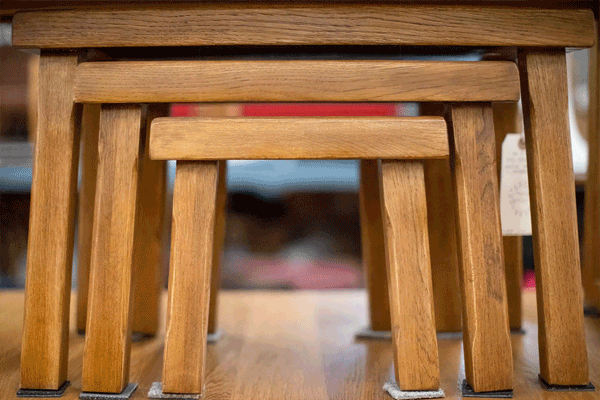A Sleuth on the Trail of American Furniture
- Share via
Learning about the history of American furniture sounds as exciting as staring at a piece of plywood. That is, unless Wendell Garrett is the teacher.
Garrett, senior vice president in the American Decorative Arts department of Sotheby’s and editor at large of Magazine Antiques, the periodical for serious collectors, speaks with passion about American decorative arts, viewing them as integral parts of American history. To Garrett, a Queen Anne chair isn’t just a place to sit; it’s a vehicle for understanding our American heritage.
“American-made furniture is really a document to our past,” he said, speaking from his New York office, one that, says a friend, is so full of books Garrett can barely squeeze into it.
Speaking recently as part of the Los Angeles Museum of Art’s Decorative Arts Council’s lecture series on collections and collectors, Garrett, a Southern California native, gave a historic overview focusing on the collections of the Vanderbilts, Fords and Rockefellers.
Because many early American settlers came from England, most of our antiques and cultural qualities came from there, as did principles of architecture, furniture design and other decorative arts.
“When people migrated, they took their best things with them,” Garrett said. And so with a few good pieces as grounding, the American settlers decided to improve upon things by adding their own touches. After all, they left England for a better world, so they proceeded to create it.
“Americans borrowed ideas, but they changed them also. As an example, the American accent is changed from the original British one. So it is with furniture,” Garrett said. “Our Queen Anne and Chippendale furniture are in many ways superior to the British styles. [Americans] took the existing forms and improved upon them.
“Here in the U.S., American furniture sells for two to three times as much as English antiques that are comparable in period and quality,” he said. “There is a great demand for it. And there is a certain amount of patriotism that goes with acquiring something from your own country.”
Garrett explained that American antiques fall into two periods: 18th century furniture is more desirable because that was the time of humanism and enlightenment. It was also the golden age of handcrafting. Nineteenth century pieces reflect historic revivals such as Gothic and rococo. Since these were machine-made, they are less expensive.
“American furniture is also sought after because it is less monumental and is stripped of the heavy ornamentation that is found on some European pieces,” he said. For most people, houses were smaller here, so the furniture reflects that. There weren’t too many castles being built.
But there were some. And that’s where American collectors like Hearst, the Vanderbilts, the Rockefellers and the Fords, among others, came in.
“It’s a paradox that the great industrialists of the 20th century who made their fortunes through machinery were the ones who revived the interest in handcrafted, handmade furniture,” Garrett said. “The Fords, Vanderbilts and Rockefellers legitimized collecting, since their collections were public so people knew what they were buying.”
*
In the first half of the century wealthy decorative arts collectors influenced the cities where they lived. For example, Ima Hogg in Houston and Henry Ford in Detroit were great collectors whose impact on their cities brought in dealers, teachers and other collectors.
“In Los Angeles,” Garrett said, “the field is pretty thin because the city’s so new. However, Norman-Gregor Wilcox [curator of decorative arts at LACMA during the 1950s] had an excellent glass collection and . . . he encouraged others.”
So although these industrial giants and their collections dominated the first half of the 20th century, things changed in the late 1940s.
After World War II, collecting became more egalitarian in America. In 1950, the Winterthur Museum in Maryland opened, Magazine Antiques began and the Norvin Green Sale of Americana at Sotheby’s took place, establishing prices of American decorative arts for the first time.
“The results of those things happening were both increased interest in antiques and escalating prices. People started looking around their houses and finding pieces that they could sell. Before then prices were in the three- and four-digit range. After 1950 they were in the fives and sixes. It was all supply and demand.”
The $100,000 mark wasn’t crossed until 1970. Since then more than a dozen pieces have gone for more than $1 million. Topping the list was a Newport desk and bookcase from the 1770s that sold at auction at Christie’s for $12 million. A turret-top Philadelphia Chippendale tea table that was found in a warehouse in La Jolla sold last year for $1 million.
*
Where are the great American collectors of today?
“It takes more than money to be a great collector; it takes knowledge. There has to be enough leisure time to study what to buy. And with prices now in the seven- and eight-figure range, no one wants to make a mistake,” Garrett said. “There are younger collectors today, but they want to remain anonymous.”
Luckily for decorative arts collectors, the stock market has little impact on price, according to Garrett.
“The blue-chip Queen Anne and Chippendale still reign. But I am seeing a move into neoclassicism, furniture from 1790 to 1820. A signed American sideboard from that period just sold for $250,000. This is the furniture that Jacqueline Kennedy used in her restoration of the White House.”
Even with prices escalating, it may still be possible to find fine furniture.
“We’re still finding pieces, especially in Florida and California, since people migrate there to retire,” he said.
What do you look for to determine quality?
“It’s important to know how to tell the difference between the good, the better and the best. Different elements of the antiques affect the price,” he said. “You should know the difference between a ‘cripple,’ a badly damaged piece; a ‘marriage,’ one antique created from two or more different antiques; a fake, a piece made to deceive; and a reproduction.”
Regionalism and periodization--where and when a piece was made--also play parts in the value, as does provenance, which is the written history of the piece.
LACMA’s Decorative Arts Council will begin its 1999 lecture series, “Design and Designers,” on Jan. 28, starting with Hutton Wilkinson speaking on Tony Duquette. Other speakers include Desmond Guinness, Tim Knox, Keith Irvine and Stephen Calloway. Proceeds from the lecture series will go to fund major acquisitions. For more information, call (323) 857-6528.


